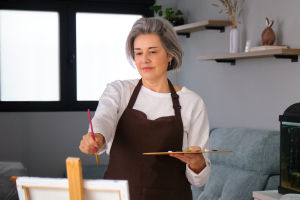Have you ever wondered how paintings can communicate more than just colors and shapes? Painting is a unique form of expression that goes beyond words, often revealing the mental and emotional states of the artist.
In this article, we will explore how painting reflects mental health and why it has become a vital tool in understanding and promoting psychological well-being.
Understanding Mental Health Through Visual Expression
Mental health is an essential aspect of overall wellness, involving our emotional, psychological, and social well-being. Sometimes, people find it difficult to articulate their feelings or experiences verbally. Painting offers an alternative means of communication, allowing artists to externalize their inner thoughts, anxieties, joys, and struggles on canvas. The colors, shapes, and strokes can provide clues to an individual's emotional state. For example, darker tones might indicate sadness or turmoil, while bright colors may express hope or happiness.
The Science Behind Art and Mental Health
Research in psychology has shown that engaging in artistic activities, such as painting, can have significant benefits for mental health. Creating art stimulates brain regions involved in motor skills, creativity, and emotional regulation.
According to a study published in the Journal of the American Art Therapy Association, art therapy has been effective in reducing symptoms of anxiety and depression. The process of painting encourages mindfulness—a state of being present in the moment—which is linked to lower stress levels and improved mood.
Painting as a Therapeutic Tool
Therapists often use painting as part of art therapy to help clients explore emotions they find difficult to express. This method provides a safe space where individuals can visually narrate their experiences without needing to use words.
The act of painting can also be cathartic, helping people release negative feelings and gain insight into their mental state. It allows a person to observe their thoughts and emotions from a new perspective, often leading to personal growth and healing.
How Different Styles Reflect Psychological States
The style of painting can also reflect the painter's mental state. Abstract art, for example, might reveal confusion or complexity, while realistic paintings might show a need for control or clarity. The intensity and speed of brush strokes can indicate agitation or calmness.
Moreover, some artists choose to repeatedly depict specific themes or symbols, which may point to unresolved issues or core emotional concerns. Understanding these nuances can provide valuable insights for mental health professionals and viewers alike.
Famous Artists and Mental Health Insights
Many renowned painters throughout history have shown how mental health influences their work. Vincent van Gogh's vivid and sometimes turbulent paintings are often discussed in the context of his psychological struggles. Frida Kahlo's self-portraits reveal physical pain and emotional resilience.
Their art continues to inspire discussions about the connection between creativity and mental health, highlighting how deeply personal experiences shape artistic expression.
Painting for Everyone: Not Just Artists
One common misconception is that painting is only for talented artists. In fact, anyone can use painting as a way to explore and improve their mental health. Community art programs and workshops encourage people from all backgrounds to participate, fostering social connection and emotional expression.
Even casual painting can offer stress relief and joy, making it an accessible form of mental health support.
How Viewers Connect Emotionally With Paintings
It's not only the artists who benefit from painting's relationship with mental health—viewers also experience emotional connections when observing art. Paintings can evoke empathy, inspire reflection, and promote emotional release.
When people engage with artwork that reflects complex feelings, they often feel understood and less alone in their experiences. This shared emotional experience is part of what makes art so powerful.
Conclusion: Your Turn to Reflect
Have you ever felt drawn to a particular painting and wondered what emotions it might hold? Or have you tried painting yourself to better understand your feelings? Painting offers a unique window into the human mind, making mental health visible and approachable.
Whether you are an artist or an admirer, engaging with painting can deepen your understanding of yourself and others. Why not pick up a brush and discover what your own mindful canvas reveals?
Let me know what emotions or thoughts come to mind when you view paintings — I'm curious to hear your experiences!


